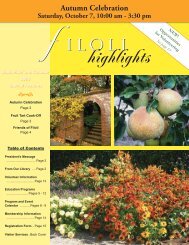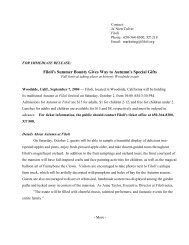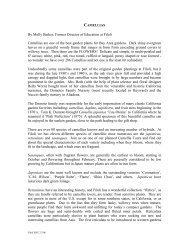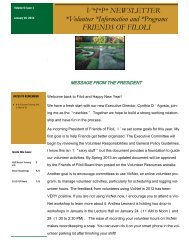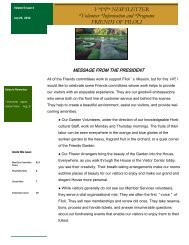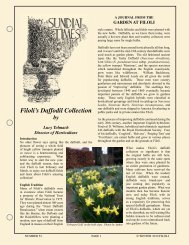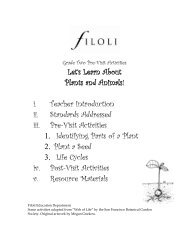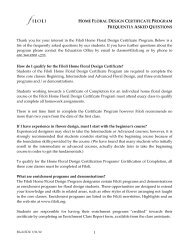You also want an ePaper? Increase the reach of your titles
YUMPU automatically turns print PDFs into web optimized ePapers that Google loves.
A B C<br />
Here, the process is depicted in an easier to visualize manner. Drawing A shows a camellia before renovation. Drawing B shows the same<br />
tree after the renovation cuts have been made. Drawing C shows the flush of new sprouts, with Circle 1 detailing the burst of new shoots,<br />
and Circle 2 showing the same branch after thinning and heading cuts have been made. All photos and drawings by the author.<br />
photo). Other buds will sprout further down the<br />
trunk, but unless the plant is in a lot of sun, there<br />
probably won’t be much sprouting in the bottom<br />
third of the plant. Since the goal of renovations<br />
at <strong>Filoli</strong> is size control in addition to flower<br />
promotion, we thin or cut back most of the new<br />
growth.<br />
Starting at the top, any new sprouts growing into<br />
the center, rather than toward the outside, can<br />
be removed or cut back to two buds. Multiple<br />
sprouts often form from the same bud. Leave the<br />
strongest, remove any others, then cut the sprout<br />
back to two buds (bottom photo, previous page).<br />
If possible, trim sprouts back to an outward facing<br />
bud. This is especially important for sprouts on<br />
the bare lower portions of the trunks. Buds sprout<br />
in the direction they are facing- outside facing<br />
buds sprout toward the outside of the plant, inside<br />
facing buds sprout toward the inside of the plant.<br />
Even the slightest directional encouragement can<br />
be helpful when training camellias. As part of<br />
the training process, horizontal branching of new<br />
shoots is to be encouraged.<br />
The rest of the plant can be pruned in a similar<br />
manner, i.e., cut back most of the new growth<br />
to two buds, thin out congested sections, and<br />
encourage horizontal branching whenever<br />
possible. Occasionally, the original renovation<br />
cuts may not have taken back the main stems<br />
to where they should optimally be located for<br />
good structural regrowth. If this is the case, the<br />
main trunks can be further cut back to maintain<br />
the shape. Any pruning should be done before<br />
the camellia sets flower buds for the next year,<br />
usually before mid-July to August. Flower buds<br />
are much fatter than vegetative buds and can be<br />
easily distinguished.<br />
All the hard pruning cuts should make the plant<br />
respond vigorously throughout the growing<br />
season. This may necessitate another pruning in<br />
the late winter to take off the longest branches to<br />
highlight the flowers. Care should be taken not<br />
to remove any flower buds that may have formed.<br />
PAGE 3<br />
1<br />
The second year after renovation should produce<br />
sporadic flowering. Pruning and training the<br />
second year is similar to the first year, with some<br />
thinning at the top and pruning to encourage<br />
horizontal branching and dense growth. The<br />
shape of the plant should start to become visible<br />
at this point and it will be easier to see what<br />
will need to be pruned to maintain the desired<br />
form. Continue in this vein year after year, and<br />
eventually the plant will become the desired size<br />
and shape.<br />
Renovation is an effective method for maintaining<br />
and reshaping old and overgrown camellias. As<br />
long as proper pruning happens in the years after<br />
renovation, plants can be safely and effectively<br />
brought back into a proper garden size. The end<br />
result, long term, will be a more beautiful, better<br />
shaped plant to enjoy for many years.<br />
For further reading on camellias and camellia<br />
renovation, please see the following excellent<br />
reference books available in the Friends of<br />
<strong>Filoli</strong> Library: The Illustrated Encyclopedia of<br />
Camellias by Stirling Macoby, Camellias: The<br />
Gardener’s Encyclopedia by Jennifer Trehane,<br />
and Camellias Illustrated by Morrie L. Sharp.<br />
Paul Cady was formerly the assistant horticulturist in the<br />
Walled and Woodland Gardens. He left <strong>Filoli</strong> last summer to<br />
pursue his Master’s Degree in Landscape Architecure from<br />
the University of Georgia.<br />
The Sundial Times<br />
The Sundial Times is a quarterly supplement to the<br />
Friends of <strong>Filoli</strong> Highlights.<br />
Jim Salyards, Editor<br />
Alex Fernandez, Managing Editor<br />
Paul Littlepage, Proofreader<br />
Paul Cady, Contributing Writer<br />
<strong>Filoli</strong>, 86 Cañada Road. Woodside, CA 94062<br />
(650) 364-8300<br />
Website: www.filoli.org; Email: jsalyards@filoli.org<br />
2



